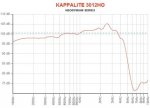Re: Virtual SMAART training: Tell the crossover frequency and type
The delays are the reference delays. Since a transfer function compares the input and the output, the input must be shifted in time to line up with the output.
The delays are indeed exceedingly long, and there is some funny business going on with how my laptop uses the new internal reference generator loop back in SMAART 7.3. I've got a DSP set up to investigate this today. The actual time values don't matter, though. All that matters is the alignment between input and output.
Because I have experience to know approximately what the phase response of the loudspeaker and DSP should look like natively, I am able to find the correct reference delay time, regardless of how long it appears to be, and how unphysical that value might seem.
I'll eventually unpack part 1. As for your other two assertions: the first makes no physical sense, and the second is incorrect.
http://www.linkwitzlab.com/crossovers.htm
I know that's brief, but I've got a full day.
What are the delays for on the DSP and Microphone for? 154ms seems crazy(173 feet?) so I don't know how that fits in to your calculations for the DSP side of it.
The delays are the reference delays. Since a transfer function compares the input and the output, the input must be shifted in time to line up with the output.
The delays are indeed exceedingly long, and there is some funny business going on with how my laptop uses the new internal reference generator loop back in SMAART 7.3. I've got a DSP set up to investigate this today. The actual time values don't matter, though. All that matters is the alignment between input and output.
Because I have experience to know approximately what the phase response of the loudspeaker and DSP should look like natively, I am able to find the correct reference delay time, regardless of how long it appears to be, and how unphysical that value might seem.
What am I really looking for here? From what I know of SMAART and it's displays, it seems that that the lower end of this box is more in phase than the higher end? Especially around 2k. Is this indicative of a lows box in the PA?
I'll eventually unpack part 1. As for your other two assertions: the first makes no physical sense, and the second is incorrect.
As far as the orders go, and what 1st order, 2nd order and all that is, I am embarrassed to say that I don't know what that is, so I can't take a stab at what those are. What does one look for to see the difference between a passive and active crossover?
http://www.linkwitzlab.com/crossovers.htm
I know that's brief, but I've got a full day.


